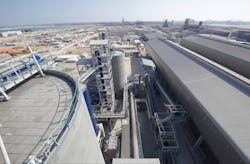How to Improve Production Efficiency and Reliability with Industrial Network Management
One of the largest greenfield industrial projects in the world, the Qatar Aluminum (Qatalum) smelter located near Mesajeed Industrial City in Qatar, was conceived to be one of the most cost-effective aluminum smelters in the world. In addition, the plant had to meet strict environmental regulations. The facility includes 17 separate plants connected via an automated process control system.
Management of Qatalum’s entire operation starts when raw materials hit the dock. It continues until the high-quality aluminum extrusion ingots and foundry alloys are containerized and loaded on ships for delivery to sites around the world.
The industrial network used to connect Qatalum’s facilities and operations was designed by ZMS Technology of Stuttgart Germany, and consists of more than 1,000 nodes. Based on his experience working on other industrial network projects, Shariq Khan, technical manager of ZMS Technology, knew that employing manual maintenance strategies or using a series of local workstations to manage cells of networks within a facility would not provide the efficiency and accuracy required for Qatalum.
Rapid Installation
Manual configuration of network devices is tedious and error-prone, especially when you’re working with a network with more than 1,000 nodes. To automate management of the network, ZMS Technology chose Hirschmann’s Industrial HiVision network management system (NMS) to smooth the way for site acceptance testing. Using this NMS, the Qatalum team was able to:
• Significantly reduce network installation time;Ensure consistency
• Ensure consistency in network infrastructure configurations; and
• Automate documentation of configuration information.
Industrial HiVision’s installation and maintenance capabilities and powerful diagnostics quickly recognized and mapped all components on the plant network, including non-Hirschmann products. The system was also able to configure common device parameters across multiple devices simultaneously, dramatically reducing the time it took to get the network ready for test. The ability of the NMS to detect inconsistencies between parameter configurations reduced troubleshooting time.
Day-to-Day Operations Streamlined
With seventeen separate units at the facility, the company often encounters cable crimping and transmission errors, such as cyclic redundancy check (CRC) errors. Many of these problems are difficult to find without the aid of a monitoring system.
The remote monitoring capabilities of Industrial HiVision were very appealing to Bashir Habib, head of IT infrastructure at Qatalum, because it allows for the easy pinpointing of such problems, which can directly affect production.
“A centralized industrial network management system is an important element in overall plant operation that allows Qatalum to consistently meet production goals,” Habib says.
For day-to-day operations, the NMS only requires oversight by a single network administrator working half-time to effectively oversee the entire network. This includes carrying out repetitive but essential maintenance tasks such as changing passwords regularly and implementing firmware updates.
Cable breakdown is a particular concern due to the heat and arid conditions in Qatar. If cables are not monitored properly they can deteriorate and cause network failures that require expensive shutdowns and emergency maintenance. Qatalum uses Industrial HiVision’s graphical interface and advanced monitoring capabilities for proactive maintenance of the system.
Industrial NMS tools also make it easy to identify problematic connections. They can dig down from the port to the switch and even to the cable to identify an area of potential failure. Having this capability practically eliminates unplanned downtime. Without the NMS, the alternative approach to fixing problem connections is to shut down a portion of the network and sending a process engineer to troubleshoot—a very expensive process.
Sustained Uptime and Cost-Effectiveness
Perhaps one of the greatest tests of the network management software came in 2012 when the system was upgraded. The upgrade required an audit on all 1,000 nodes. In addition, nearly 100 changes were implemented and checked.
The audit required a complete review of the network, starting with the layer 2 switches and following the network infrastructure throughout the facility. This thorough audit involved checking switches, network backbone and firewall connections to the IT department, verifying each PLC’s attachment to the network, as well as conducting a damage assessment and accurately mapping the thousands of cables used.
“It took us eight days to complete the audit. If we had had to do it manually, it would have taken months, and even then we would not have been 100 percent sure the upgrade was complete. Industrial HiVision allowed us to manage the whole process with just a few clicks,” said Khan.
Network Management Lessons
At the scale of an operation like Qatalum, only automated component management using a NMS made sense. However, the benefits achieved here apply equally to smaller projects.
The insight provided by an NMS into the details of the network’s operation provide a quick payback in terms of engineer productivity. When you factor in the additional benefits of improved reliability and auditing, it makes sense to consider use of an NMS as your Ethernet network develops from ad hoc to infrastructure.
Sidebar
Key NMS Characteristics
If you’re serious about moving your network from an ad hoc state to a true infrastructure, here are few key things to be aware of as you explore network management systems.
To meet the needs of industrial applications, network management systems should have:
- A highly visual interface that makes sense to automation engineers;
- Support for industrial topologies;
- Integration with SCADA devices; and
- The ability to monitor devices from different vendors.
To be effective in improving the efficiency and reliability of the network and minimize production downtime, the NMS should be able to:
- Map all the components, from various vendors, on the network;
- Configure common parameters across multiple devices simultaneously;
- Detect inconsistencies between parameter configurations;
- Offer event logging, filtering and forwarding; and
- Allow for remote access and monitoring.

